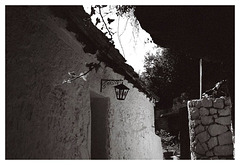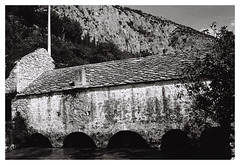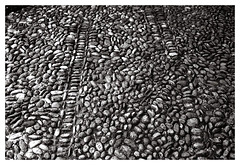
Herzegovina 2006 BW
Folder: Balkans
Herzegovina (orig. Hercegovina / Херцеговина) is the southern and smaller of two main geographical regions of Bosnia and Herzegovina. It has never had strictly defined geographical or cultural-historical borders, nor has it ever been defined as an administrative whole in the geopolitical and economic subdivision of the country. The land area of Herzegovina is around 11,500–12,300 km2 (23–24% of BH…
(read more)
City Hall, a living testament to Sarajevan resilie…
| |
|
|
This is the only photo in the album, which is from Sarajevo and thus is not from Herzegovina. This was made by no mistake. As the southern part of the country is often neglected and referred as Bosnia, so for once I decided them to should shut up and dance along.
I must also say, that the same model was applied for Slovakia in the times of Czechoslovakia, and the Slovaks were lukewarmly referred as Czechs. Similarly, but with more awareness, the USSR citizens were also addressed as Russians (even thought people more or less understood that many of them were of different nationality).
And the part of the irony is that I write this in English language, as particularly the Anglo-Saxon or English speaking world is the most self centered in this context.
Mostar, stari most
| |
|
|
F1000003
| |
|
F1000004
| |
|
I've been waiting for the night to fall
| |
|
|
F1000006
| |
|
Muslim headstones
| |
|
|
The old gravestones look like a human head with a turban, but the new ones are simple boards.
F1000008
| |
|
F1000009
| |
|
|
Sad memory
| |
|
|
F1000011
| |
|
|
In a traditional house
| |
|
|
In the silent streets of a traditional village
| |
|
|
|
Blagaj tekke
| |
|
|
|
The Tekke (khanqah, dervish house), set at the source of the river Buna, was and still is a venue for dervish Zikr praise-chanting three nights weekly. Built at the site of an earlier Bogomil sanctuary, it is a place of which history has no precise and stored data.
Archeological excavations have found and confirmed that this location holds the remains of a Late Antique structure. During the Middle Ages, even before the arrival of the Ottomans, it was a place of utter cultural and religious importance (1454). The first written track of the Tekke was made by Evlija Celebija in 1664. in his travelogues, at time when the Tekke was already well-known throughout the Ottoman empire and within the scientific community.
Throughout its history the housing complex next to the Tekija was rebuilt and redecored on multiple occasions. The Tekija was actively open until its last shaykh Sejdo Sehovic died in 1925.
After the Second World War, activities of the dervishes and the Tekke in Bosnia and Herzegovina were officially banned. Until early 70s, the Tekija was managed by the National Museum of B&H. Since then until 1974. it was officially without a trustee, after which time the Islamic Community, with no previous government consent, started using and protecting it from further delapidation. By reviving the tradition of the pilgrimage site, the common annual Mawlid (religious celebration of the birth of prophet Mohammad S.a.v.s.), the Tekke started reestablishing its previous importance. The last reconstruction of the Tekke was done in 2013. and a year later, in 2012. the completely destroyed housing complex – musafirhana (guest house) at its entrance were reconstructed as well.
River, stone, mountain, sky
| |
|
|
|
The mills by the Tekke. Very close to the source of the river Buna, channels branch off leading water to power the mills. Several mills, stamping mills and two fulling mills were built. There was one mill on each bank of the river. Part of the mill on the right bank of the river has been converted into a souvenir shop; all that remains of the rest of the mill is the stone walls. As a rule mill buildings are simple stone-built structures with gabled roofs clad with stone slabs, and with one or more mills.
whc.unesco.org/en/tentativelists/5280
Over there I'd like to have a sleeping room
| |
|
|
Game of pebbles
| |
|
|
|
Alone in the shadow
| |
|
|
Jump to top
RSS feed- Latest items - Subscribe to the latest items added to this album
- ipernity © 2007-2024
- Help & Contact
|
Club news
|
About ipernity
|
History |
ipernity Club & Prices |
Guide of good conduct
Donate | Group guidelines | Privacy policy | Terms of use | Statutes | In memoria -
Facebook
Twitter


















